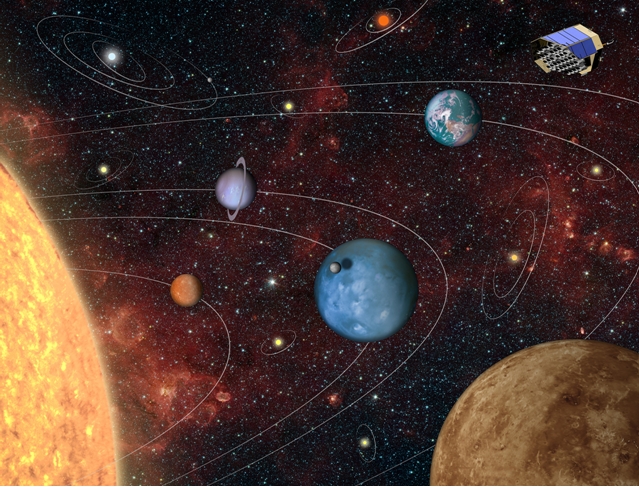Searching for New Worlds with PLATO
Space eye with 34 telescopes will investigate one million stars Spain participaes actively in the mission
Space eye with 34 telescopes will investigate one million stars Spain participaes actively in the mission
The exploration of planets around stars other than the Sun, known as extrasolar planets or ‘exoplanets’, is one of the most exciting topics of 21st century science. One of the key goals of this research is to discover and learn the properties of Earth-like worlds in the Sun’s neighbourhood. ESA, the European Space Agency, will do this in preparing a new space mission named PLATO. The mission’s launch is scheduled for 2024, and firm discoveries of Earth-like planets at Earth-like distances from stars similar to our Sun will be produced after three years of observational data have been collected. ESA’s Science Programme Committee voted for PLATO at its regular meeting in Paris on 19th and 20th February, 2014, where it was one of five proposed space projects for a so-called “M” or “medium-class” mission.
Not a single Earth-like exoplanet in a habitable zone around a star similar to our Sun has been found and fully characterized yet. PLATO will be a pioneer in finding new worlds for humanity to investigate. The mission consortium is led by Dr Heike Rauer at DLR, the German Aerospace Center. “PLATO will begin a completely new chapter in the exploration of extrasolar planets” Dr Rauer confidently predicts. “We will find planets that orbit their star in the life-sustaining ‘habitable’ zone: planets where liquid water is expected, and where life as we know it can be maintained.”
The mission has a major Spanish contribution of both companies and research centers, among which are the AstroMadrid consortium and the Instituto de Astrofisica de Andalucia (IAA-CSIC). In addition, the Spanish community participates in the international consortium PLATO over ten scientific work packages for mission preparation, processing, analysis and interpretation of future mission data, as well as support and ground tracking instruments as CARMENES@3.5-CAHA. These commitments are the result of experience gained in other projects such as CoRoT and Kepler, where the Spanish participation has been essential, and which ensures a first class scientific return to Spain.
SPACE EYE WITH 34 TELESCOPES
PLATO will measure the sizes, masses, and ages of the planetary systems it finds, so detailed comparisons with our own Solar System can be made. “In the last 20 years more than one thousand exoplanets have been discovered, with quite a few multi-planetary systems among them”, Rauer explains. “But almost all of these systems differ significantly from our Solar System in their properties, because they are the easiest-to-find examples. PLATO firmly will establish whether systems like our own Solar System, and planets like our own Earth are common in the Galaxy.” Scientists need a complete picture of all kinds of planetary systems to better understand how planets and their systems form and evolve.
PLATO, is an acronym for PLanetary Transits and Oscillations of Stars. PLATO will find planets through the periodic dimming of the detected starlight caused by a planet orbiting in front of the star, blocking PLATO’s view of a fraction of the starlight. PLATO will also measure tiny changes in detected starlight caused by small vibrations in the host stars, performing so-called astroseismology. Just as in seismology of the Earth, these vibrations reveal the interior structure of the vibrating body. Astroseismology allows us to learn the age of the vibrating star and the planets orbiting around it.
With PLATO, Europe will be leading the search for habitable exoplanets.

Artist’s rendition of ESA’s space-telescope PLATO eying into new, exotic worlds, a planetary system with gas giants and Earth-like planets resembling our Earth – and several more distant stars with planets orbiting them. Credits: DLR (Susanne Pieth).
